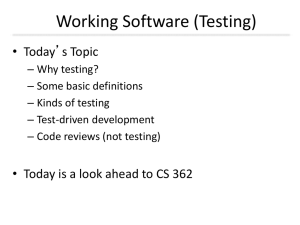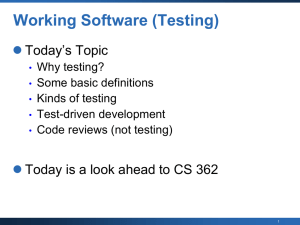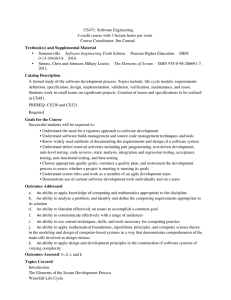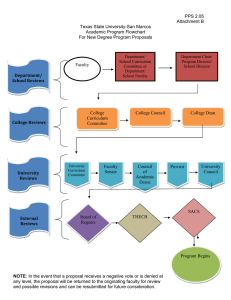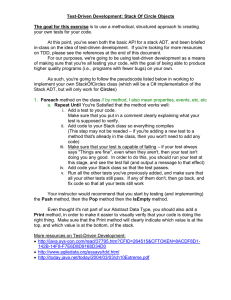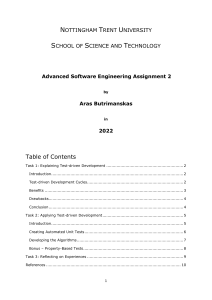Software Testing
advertisement
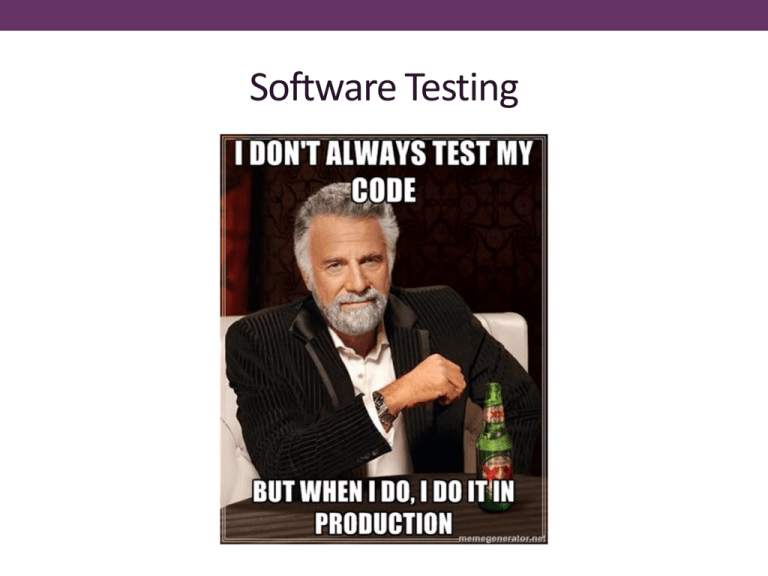
Software Testing
Making Software Work
• Today's Topics
• Why testing?
• Some basic definitions
• Kinds of testing
• Test-driven development
• Code reviews (not testing)
• Today is a look ahead to CS 362
• If you're already taking CS362, I apologize for the redundancy!
Why Testing?
• Ideally: we'd prove code
correct, using formal
mathematical techniques
(with a computer, not chalk)
• Extremely difficult: for some trivial programs (100 lines) and many small (5K
lines) programs
• Simply not practical to prove correctness in most cases – often not even for
safety or mission critical code
Why Testing?
• Nearly ideally: use symbolic or abstract
model checking to prove that a model is correct
• Automatically extract a mathematical abstraction from code
• Prove properties with model over all possible executions
• In practice, can work well for very simple properties ("this
program never crashes in this particular way"), of some
programs, but can't handle complex properties ("this is a
working file system")
• Doesn't work well for programs with complex data
structures (like a file system)
• Can't validate your requirements either!
As a last resort…
• … we can actually run the program, to see if it works
• This is software testing
• Always necessary, even when you can prove correctness – because the
proof is seldom directly tied to the actual code that runs
"Beware of bugs in the above code; I have only
proved it correct, not tried it" – Knuth
NOT a last resort…
• Testing is a critical part of every software development effort
• Can too easily be left as an afterthought, after it is expensive to
correct faults and when deadlines are pressing
• The more code that has been written when a fault is
detected, the more code that may need to be changed to
fix the fault
• Consider a key design flaw: better to detect with a small prototype, or after
implementation is "finished"?
• May "have to ship" the code even though it has fatal flaws
Testing and Reviews in Processes
• Waterfall
Requirements analysis
Prototyping
Design
Implementation
Testing
Operation
Testing and Reviews in Processes
• Spiral
Draft a menu of
program designs
Analyze risk &
prototype
Draft a menu of
architecture designs
Draft a menu of
requirements
Analyze risk &
prototype
Establish
requirements
Plan
Establish
architecture
Plan
Operation
Analyze risk &
prototype
Testing
Implementation
Establish
program design
Testing and Reviews in Processes
• Agile
Do "spike" to evaluate & control risk
Customer provides "stories"
(short requirement snippets)
Prioritize
stories and plan
Operation
Write/run/modify
unit tests
Implement
System and acceptance tests
Testing saves lives and money
• NIST report, "The Economic Impacts of Inadequate
Ariane 5:
Infrastructure for Software Testing" (2002)
exception-handling
• Inadequate software testing costs the US alone between $22 bug : forced self
and $59 billion annually
destruct on maiden
• Better approaches could cut this amount in half
flight (64-bit to 16-bit
conversion: about
370 million $ lost)
• Major failures: Ariane 5 explosion, Mars Polar Lander,
Intel's Pentium FDIV bug
• Insufficient testing of safety-critical software can cost
lives: THERAC-25 radiation machine: 3 dead
• We want our programs to be reliable
• Testing is how, in most cases, we find out if they are
Mars Polar
Lander crash
site?
THERAC-25 design
Testing is as Glorious as Development
• Testing used to be thought as
of grunt work
• With the advent of unit
testing, regression testing,
automated testing, and the
necessary “closeness”
between requirements and
testing…
• Testing is no longer just grunt
work
• You need the same technical
skills and abilities as developers
do
• Today's Topic
•
•
•
•
•
Why testing?
Some basic definitions
Kinds of testing
Test-driven development
Code reviews (not testing)
Basic Definitions: Testing
• What is software testing?
• Running a program
• Generally, in order to find faults
(bugs)
• Could be in the code
• Or in the spec
• Or in the
documentation
• Or in the test case…
Terms: Test case vs. Test Suite
• Test case (or test): one execution of the program, that may
expose a bug
• Test suite: a set of executions of a program, grouped together
• A test suite is made of test cases
• Tester: a program (or a person!) that generates tests
Terms: Coverage
• Coverage measures or metrics
• Abstraction of "what a test suite tests" in a structural sense
• Common measures:
• Statement coverage
• a.k.a line coverage or basic block coverage
• Ideally, all of the test cases covers every line of code
• Decision coverage
• Which boolean expressions in control structures evaluated to both
true and false during suite execution
• Path coverage
• Which paths through a program's control flow graph are taken in the
test suite
• Ideally, every branch in the code is covered!
• Mutation coverage
• Ability to detect random variations to the code
• Today's Topic
•
•
•
•
•
Why testing?
Some basic definitions
Kinds of testing
Test-driven development
Code reviews (not testing)
Kinds of testing
• Whitebox
• Unit
• Blackbox
• Integration
• System
• Acceptance
• Regression
(These aren’t mutually exclusive!)
Terms: Black Box Testing
• Black box testing
• Treats a program or system as a
• That is, testing that does not look at source code or
internal structure of the system
• Send a program a stream of inputs, observe the
outputs, decide if the system passed or failed the
test
• Abstracts away the internals – a useful perspective
for integration and system testing
• Sometimes you don't have access to source code,
and can make little use of object code
• True black box? Access only over a network
Terms: White Box Testing
• White box testing
• Opens up the box!
• (also known as glass box, clear box, or structural
testing)
• Use source code (or other structure beyond
the input/output spec.) to design test cases
Stages of Testing
• Unit testing is the first phase, done by
developers of modules
• Integration testing combines unit-tested
modules and tests how they interact
• System testing tests a whole program to make
sure it meets requirements
• Acceptance testing by users to see if system
meets actual use requirements
Stages of Testing: Unit Testing
• Unit testing is the first phase, mostly done by
developers of modules
• Typically the earliest type of testing done
• Unit could be as small as a single function or method
• Often relies on stubs to represent other modules and
incomplete code
• Unit testing tools are available for most popular
languages, for example:
• JUnit (http://junit.org)
• Simpletest for PHP (http://simpletest.org)
• YUI test for Javascript
(http://yuilibrary.com/projects/yuitest/)
• Python and Ruby have unit testing built into their
language packages
Stages of Testing: Integration Testing
• Integration testing combines unit-tested
modules and tests how they interact
• Relies on having completed units
• After unit testing, before system testing
• Test cases focus on interfaces between
components, and assemblies of multiple
components
• Often more formal (test plan presentations)
than unit testing
Stages of Testing: System Testing
• System testing tests a whole program to make
sure it meets requirements
• After integration testing
• Focuses on "breaking the system"
• Defects in the completed product, not just in
how components interact
• Checks quality of requirements as well as the
system
• Often includes stress testing, goes beyond
bounds of well-defined behavior
An aspect of System Testing: Functional Testing
• Functional testing is when a developer tests a program from a
"user's" perspective – does it do what it should?
• It's a different mindset than unit testing, which often proceeds
from the perspective of other parts of the program
• Module spec/interface, not user interaction
• Sort of a fuzzy line – consider a file system – how different is the use by a
program and use of UNIX commands at a prompt by a user?
• Building inspector does "unit testing"; you (or user), walking
through the house to see if its livable, perform "functional
testing"
• Kick the tires vs. take it for a spin?
Stages of Testing: Acceptance Testing
• Acceptance testing by users to see if system
meets actual use requirements
• Black box testing
• By end-users to determine if the system
produced really meets their needs
• May revise requirements/goals as much as find
bugs in the code/system
Appropriate at all times: Regression Testing
• Regression testing
• Changes can break code, reintroduce old bugs
• Things that used to work may stop working (e.g., because of another "fix") –
software regresses
• Usually a set of cases that have failed (& then succeeded) in the past
• Finding small regressions is an ongoing research area – analyze
dependencies
". . . as a consequence of the introduction of new bugs, program
maintenance requires far more system testing. . . . Theoretically, after
each fix one must run the entire batch of test cases previously run against
the system, to ensure that it has not been damaged in an obscure way. In
practice, such regression testing must indeed approximate this theoretical
idea, and it is very costly."
- Brooks, The Mythical Man-Month
Today's Topic
•Why testing?
•Some basic definitions
•Kinds of testing
•Test-driven development
•Code reviews (not testing)
Test-Driven Development
• One way to make sure code is tested as early as possible
is to write test cases before the code
• Idea arising from Extreme Programming and often
used in agile development
• Write (automated) test cases first
• Then write the code to satisfy tests
Test-Driven Development
• How to add a feature to a program, in test-driven
development
• Add a test case that fails, but would succeed with the
new feature implemented
• As a corollary, your interfaces, inputs, and outputs need
to be well-defined!
• Run all tests, make sure only the new test fails
• Write code to implement the new feature
• Rerun all tests, making sure the new test succeeds
(and no others break)
Test-Driven Development Cycle
Example 1: What should I test ?
Consider this method (in Python):
#!/usr/bin/python
…
def readfile(gamesfile):
fh = open(gamesfile, "r”)
print "Games released in 2013:"
for line in fh:
record = line.split(",")
if record[2] == '2013\n':
print record[1]
fh.close()
Data in file:
0,Retrovirus,2013
1,Bastion,2011
2,VVVVVV,2010
What would you test?
• gamesfile with empty string
• gamesfile that doesn’t exist
on disk
• The data in gamesfile:
• A file with Windows style
linefeeds vs. Unix
• Records with too many
commas
• Records with not enough
commas
Example 2: What should I test?
Consider this method (in Javascript):
function feet_to_inches(input) {
var inches = 0;
var matchResult = input.match(/(\d+)'\s*(\d*)"/i);
if (typeof matchResult[1] !== 'undefined') {
inches += parseInt(matchResult[1]) * 12;
}
if (typeof matchResult[2] !== 'undefined') {
inches += parseInt(matchResult[2]);
}
return inches;
}
What would you test?
• 5’6”
• 5’ 6”
• 5 6”
• 7”
• 5’
• 5’6
• 15’ 12113”
Test-Driven Development Benefits
• Results in lots of useful test cases
• A very large regression set
• Forces attention to actual behavior of software:
observable & controllable behavior
• Only write code as needed to pass tests
• And may get good coverage of paths through the
program, since they are written in order to pass the tests
• Reduces temptation to tailor tests to idiosyncratic
behaviors of implementation
• Testing is a first-class activity in this kind of
development
Test-Driven Development Problems
• Need institutional support
• Difficult to integrate with a waterfall development
• Management may wonder why so much
time is spent writing tests, not code
• Lots of test cases may create false confidence
• If developers have written all tests, may be blind spots
due to false assumptions made in coding and in testing,
which are tightly coupled
• Can be a poor use of time
• If you aren’t exactly sure what modules or data structures
you need, you might spend a lot of time modifying tests
instead of doing it right the first time
Exhaustive vs. Representative Testing
• Can we test everything?
• File system is a library, called by other components of some flight
software
Operation
Result
mkdir ("/eng", …)
mkdir ("/data", …)
creat ("/data/image01", …)
creat ("/eng/fsw/code", …)
mkdir ("/data/telemetry", …)
unlink ("/data/image01")
SUCCESS
SUCCESS
SUCCESS
ENOENT
SUCCESS
SUCCESS
File system
/
/eng
/data
image01
/telemetry
Example: File System Testing
• How hard would it be to just try "all" the possibilities?
• Consider only core 7 operations (mkdir, rmdir, creat,
open, close, read, write)
• Most of these take either a file name or a
numeric argument, or both
• Even for a "reasonable" (but not provably safe)
limitation of the parameters, there are 26610
executions of length 10 to try
• Not a realistic possibility (unless we have 1012
years to test)
• Today's Topic
•
•
•
•
•
Why testing?
Some basic definitions
Kinds of testing
Test-driven development
Code Reviews (not testing)
Not Testing: Code Reviews
• Not exactly testing, but an important method for finding bugs
and determining the quality of code
• Code walkthrough: developer leads a review team
through code
• Informal, focus on code
• Code inspection: review team checks
against a list of concerns
• Team members prepare in advance
in many cases
• Team moderator usually leads
Not Testing: Code Reviews
• Code inspections have been found to be one of the most
effective practices for finding faults
• Some experiments show removal of 67-85% of defects via
inspections
• Some consider XP's pair programming as a kind of "code
review" process, but it's not quite the same
• Why?
• Can review/walkthrough requirements
and design documents, not just code!
